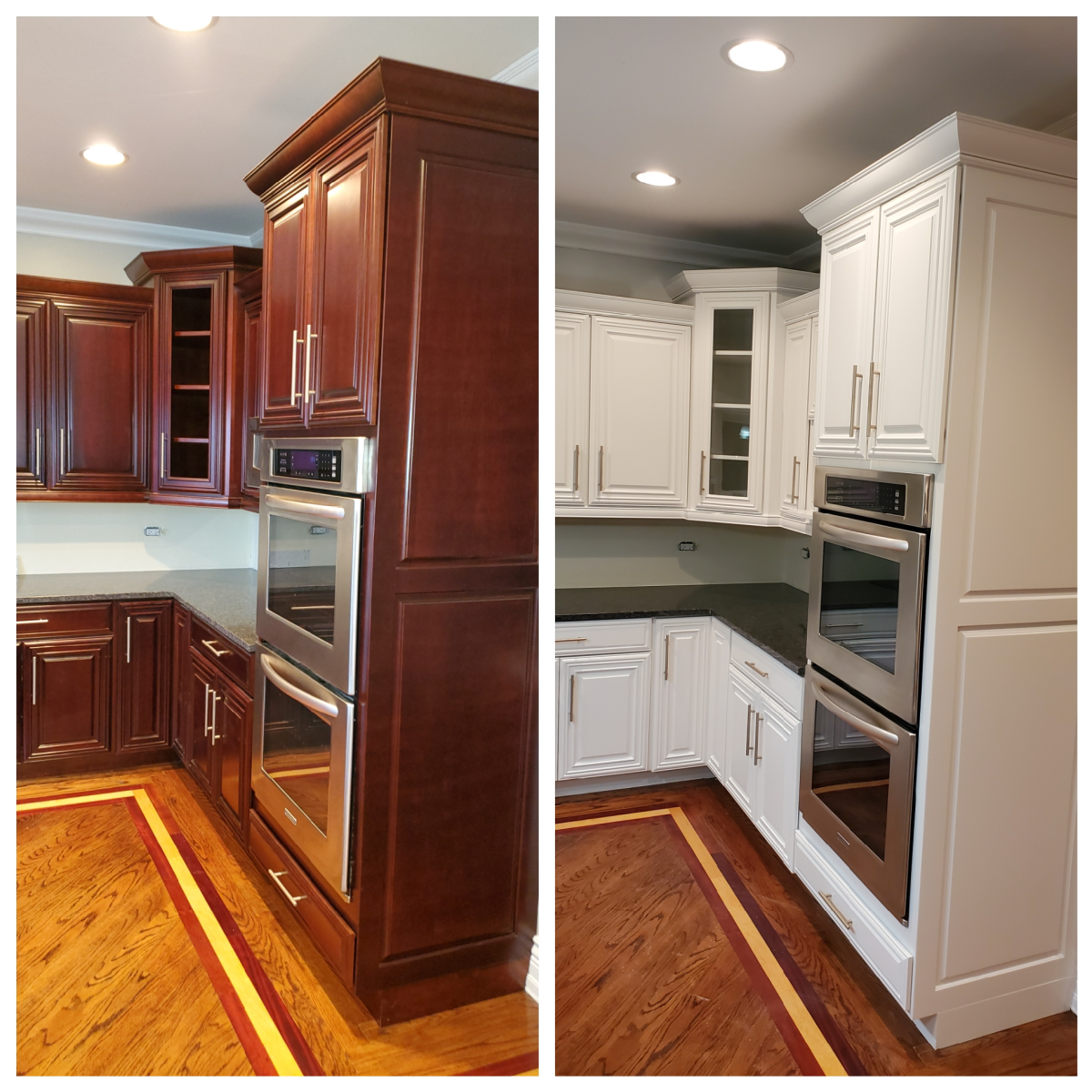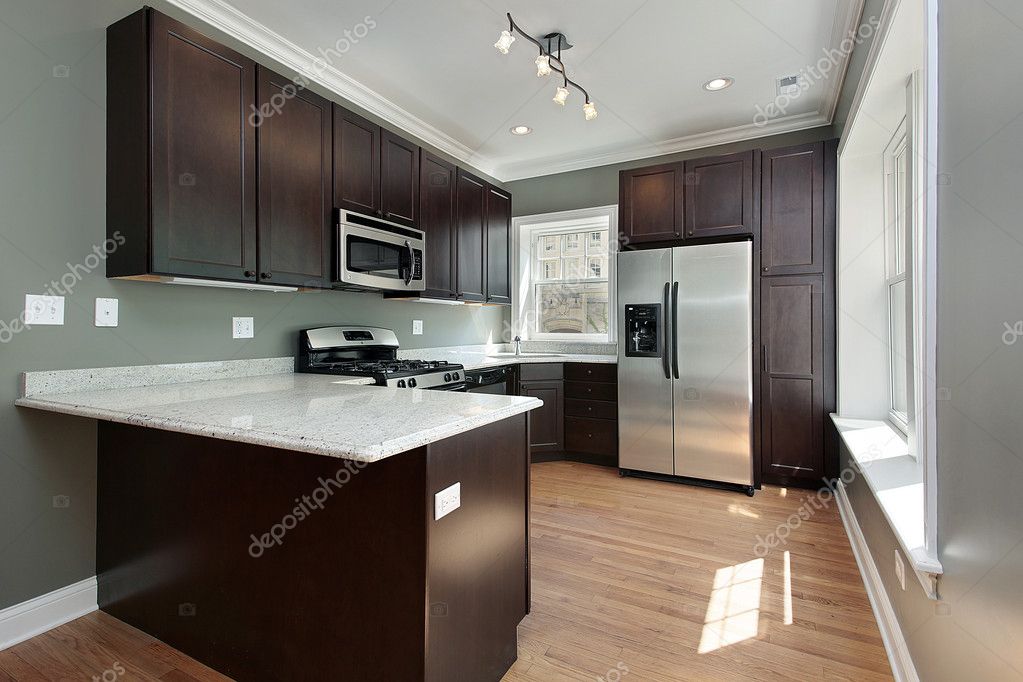Understanding the Process

Whitewashing dark wood cabinets is a popular technique for achieving a light, airy, and refreshed look. It involves applying a thin layer of white paint, diluted with water or a whitewashing solution, to the wood surface. The resulting finish allows the wood grain to show through, creating a subtle and elegant effect.
The Chemical Reaction Involved in Whitewashing
Whitewashing involves a chemical reaction between the white paint and the wood. The white paint, usually a mixture of pigments and binders, reacts with the tannins in the wood, creating a lighter shade. This reaction is similar to how tea stains a cup. The tannins in the wood react with the pigments in the paint, resulting in a color change.
The Difference Between Whitewashing and Painting
Whitewashing is distinct from painting in several ways. While both involve applying a coating to a surface, whitewashing aims for a translucent finish that allows the wood grain to show through. Painting, on the other hand, creates a solid opaque finish that completely covers the wood grain.
Preparing the Cabinets for Whitewashing
Proper preparation is crucial for achieving a successful whitewash finish. Here’s a step-by-step guide:
- Clean the cabinets: Thoroughly clean the cabinets with a mild detergent and water. This removes any dirt, grease, or grime that may interfere with the whitewash adhesion.
- Sand the cabinets: Sanding the cabinets with fine-grit sandpaper helps create a smooth surface for the whitewash to adhere to. This also helps to open up the wood pores, allowing the whitewash to penetrate better.
- Prime the cabinets: Priming the cabinets with a stain-blocking primer is essential, especially if the cabinets are dark or have a strong stain. The primer prevents the dark wood from bleeding through the whitewash, ensuring a more consistent finish.
- Apply masking tape: If you want to protect certain areas, such as the hardware or the surrounding walls, use masking tape to create a clean line.
Choosing the Right Products

Picking the right whitewash is key to achieving the desired look for your cabinets. Different whitewash products have distinct properties that impact the final finish. Understanding these variations will help you choose the best option for your project.
Types of Whitewash Products, How to whitewash dark wood cabinets
There are several types of whitewash products available, each with its own advantages and drawbacks.
- Milk Paint: Made from milk protein, lime, and pigment, milk paint offers a natural, matte finish with a slightly chalky texture. It’s easy to apply and provides good adhesion to various surfaces, including wood. However, it’s less durable than other options and can be susceptible to water damage.
- Chalk Paint: This paint is formulated with calcium carbonate, giving it a matte, chalky finish. It’s known for its ease of application and ability to cover imperfections. Chalk paint is also versatile, allowing for distressing and antiquing effects. However, it’s not as durable as traditional paint and requires sealing for protection.
- Whitewash Stain: This product combines a translucent white pigment with a stain base. It offers a lighter, more transparent finish than paint, allowing the wood grain to show through. Whitewash stain is generally more durable than milk paint or chalk paint and can be applied with a brush, rag, or spray.
- Acrylic Paint: Diluted acrylic paint can also be used to create a whitewash effect. It offers good adhesion and durability but may require multiple coats to achieve the desired opacity.
Factors to Consider When Choosing Whitewash
Several factors influence the selection of the right whitewash product:
- Wood Type: The type of wood you’re working with affects how the whitewash will adhere and appear. For example, porous woods like pine or oak will absorb more whitewash, resulting in a more opaque finish.
- Desired Finish: Consider the level of opacity and the desired texture. If you want a subtle, translucent finish, a whitewash stain might be the best choice. For a more opaque, chalky look, milk paint or chalk paint would be suitable.
- Durability: If your cabinets are subjected to frequent use or moisture, a more durable whitewash option like whitewash stain or acrylic paint is recommended.
Benefits and Drawbacks of Different Formulations
Here’s a summary of the advantages and disadvantages of each type of whitewash:
| Type | Benefits | Drawbacks |
|---|---|---|
| Milk Paint | Natural, matte finish, good adhesion, easy to apply | Less durable, susceptible to water damage |
| Chalk Paint | Matte, chalky finish, covers imperfections, easy to apply, versatile | Not as durable as traditional paint, requires sealing |
| Whitewash Stain | Translucent finish, shows wood grain, durable | May require multiple coats for full opacity |
| Acrylic Paint | Good adhesion, durable | May require multiple coats for desired opacity |
Techniques and Application: How To Whitewash Dark Wood Cabinets

Applying whitewash to cabinets is a relatively straightforward process, but it requires a few key techniques to achieve a professional and even finish. This section will guide you through the steps involved in whitewashing your cabinets, ensuring a beautiful and unique look.
Essential Tools and Materials
Before you begin, gather the necessary tools and materials. Having everything ready will make the process more efficient and enjoyable.
Here is a list of essential tools and materials:
- Whitewash: Choose a pre-mixed whitewash or create your own using paint, water, and a binder (like glue or glaze).
- Paintbrushes: Use a high-quality brush with soft bristles, suitable for applying whitewash evenly.
- Paint Roller: For larger surfaces, a roller will help cover the cabinets quickly and efficiently.
- Paint Tray: A paint tray with a liner will help you manage the whitewash and keep your workspace clean.
- Sandpaper: Use fine-grit sandpaper to smooth out any imperfections in the wood before applying the whitewash.
- Drop Cloth: Protect your floors and surrounding areas from spills and drips.
- Cleaning Supplies: Keep cleaning supplies like rags, water, and soap handy for any messes.
- Safety Gear: Wear gloves and a mask to protect your hands and respiratory system from paint fumes.
Whitewash Application Techniques
Applying whitewash involves several techniques, each offering a unique effect. Understanding these techniques will help you achieve the desired look for your cabinets.
- Single-Coat Application: This technique involves applying a single, thin coat of whitewash to the cabinets. This method provides a subtle, semi-transparent finish, allowing the wood grain to show through.
- Multiple-Coat Application: This technique involves applying multiple thin coats of whitewash, allowing each coat to dry completely before applying the next. This method creates a more opaque finish, reducing the visibility of the wood grain.
- Distressed Look: To achieve a distressed look, apply whitewash with a dry brush, using a back-and-forth motion to create uneven streaks and a weathered appearance.
- Sponge Application: Use a damp sponge to apply whitewash, dabbing it onto the surface in a random pattern. This method creates a soft, textured effect.
- Rag Application: This technique involves applying whitewash with a clean cloth, wiping it onto the surface in a circular motion. This method creates a more even and uniform finish.
How to whitewash dark wood cabinets – Yo, wanna give your dark wood cabinets a fresh look? Whitewashing’s the way to go! It’s like a makeover for your kitchen. But hey, if you’re feeling extra creative, check out these photo collage ideas for bedroom wall diy.
You can totally rock a DIY photo collage on your wall while you’re working on those cabinets. It’ll be like a total vibe shift! Anyway, back to the whitewashing – you’ll need some paint thinner, sandpaper, and a light-colored paint.
Just follow the steps and you’ll be good to go!
Yo, so you wanna give your dark wood cabinets a fresh look? Whitewashing is the way to go, man. It’s like giving them a whole new vibe. And if you’re into that minimalist, chill aesthetic, check out these grey velvet bedroom ideas.
They’ll make your space feel like a sanctuary. Back to those cabinets, you can use a mix of white paint and water for a lighter look. Just make sure you sand ’em down first. Peace out.